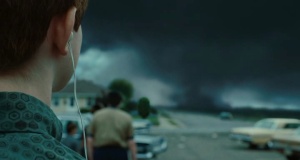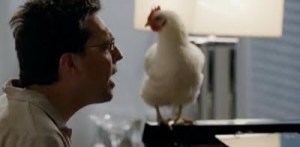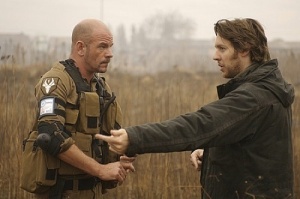You are currently browsing the category archive for the ‘Lists’ category.
So, remember what I said before about the trouble finding pictures? Well, as luck would have it, all 10 films to land on my best endings list happen to be on DVD (trust me, I couldn’t have planned that if I tried), and luckily I own 6 of them. So I’m psyched to get this particular list out to you guys much more quickly than I expected.
To make a great ending, it’s not as simple as creating bold images or throwing in unexpected plot twists. For an ending to truly soar, it has to be earned. The 10 films on this list all earn their powerful conclusions in one way or another, and shock and surprise the viewer in extraordinary ways.
I probably shouldn’t have to tell you this, but, seeing as we’ll be discussing some endings in detail, spoilers abound. You’ve been given fair warning.
The year’s finest finales are:
#10
Paranormal Activity (Director: Oren Peli)
The unfortunate fact of the matter is that too much hype can kill even the purest of joys. For my money, there was no horror thrill purer than the final moments of Paranormal Activity, the most profitable film of all time. While the film’s original ending is much more chilling, the ending of the theatrical cut is jump-out-of-your-seat magic. I have never seen a horror film that has made me scream out loud in a theatre. Well, at least I never had, until Micah’s body came hurtling towards the camera. Seeing the demonic Katie approach the camera is a somewhat cheap moment that I didn’t really need, but it doesn’t rob the initial scare of its raw power.
#9
District 9 (Director: Neill Blomkamp)
It’s just about as sobering an ending as you can get out of a blockbuster action film. After a few final testimonials from the loved ones of Wikus van de Merwe, his wife mentions a mysterious trinket left on her doorstep. With one cut, we learn exactly where it came from, and our hearts break. Because Wikus’ wife will never know that her husband is still alive. Because who knows if she would want to know that he’s fully transformed into a Prawn. Because we know Wikus is still waiting for Christopher Johnson to return. But more than anything, its Wikus’ undying love and humanity after his transformation that makes the film’s final shot an emotional powerhouse. It is the one pure and beautiful thing to come out of the bleak landscape of Jo-burg.
#8
The Hurt Locker (Director: Kathryn Bigelow)
The most striking thing about the ending of this year’s soon-to-be Best Picture winner (bet on it) is the odd disconnect between the bias of its largely liberal audience and Sgt. William James’ actual experience. For most people watching The Hurt Locker, James has dodged a bullet, served his time, and gotten out of jail; he’s lucky to be alive. But the truth of the matter is never that simple. What James truly finds on the other side of the world is that his home is no longer familiar. The same things we take comfort in or take for granted seem cold or mundane. In an image that sends the viewer for a loop, the cereal aisle at a local grocery store becomes alien and oppressive. James has never felt more alone before this moment. To quote this year’s other (and, for my money, superior) Iraq war offering The Messenger, it’s like coming back from another planet. Sgt. James’ inevitable return to combat only adds a more bitter after-taste, as the countdown to the end of his rotation starts over again at 365 days.
#7
Drag Me To Hell (Director: Sam Raimi)
The climax to Sam Raimi’s triumphant return to horror is a bit on the O. Henry side (the envelope Christine returns to Mrs. Ganush’s grave is, in fact, her boyfriend Clay’s rare quarter, not the accursed button from her coat), but there’s no other way for the story to end. In the end, the film isn’t about a woman who makes a mistake and gets what she deserves. It’s a surprisingly psychological shocker, as Christine gets exactly what she thinks she deserves. After spending years of her life hiding from her past and trying to blame all of her problems on other people, Christine is tired of running. Denying the loan to Mrs. Ganush was just the straw that broke the camel’s back as Christine tailspins into guilt and madness. In her mind, she deserves to suffer forever, and so she does. Chills ran through my body as Christine is forced down into an eternity of damnation, and the sight of her face melting off in the flames cannot be unseen. Suddenly, the title card flashed on the screen after the film’s final images declares Drag Me To Hell not as a looming threat, but a desperate plea for escape from a life that has become torturous.
#6
A Serious Man (Directors: Joel and Ethan Coen)
It’s interesting that the Coens and their former collaborator and comrade Sam Raimi both cover such similar thematic territory, albeit in dissimilar ways. After suffering God’s body blows for 90 minutes, Larry Gopnik and his son Danny have finally found some peace in the world. Though Larry never gets to hear it, Rabbi Marshak has dispensed the most simple and powerful advice of the whole film: “Be a good boy.” Larry and Danny have reached the same point by doing nothing. With a new lease on life, they are both driven to action, but completely against Marshak’s advice. Danny continues to listen to his radio during class, and Larry, in a moment of desperation, changes Clive’s failing exam grade, allowing him to accept the bribe to help pay for his brother’s legal fees. Not a moment later, a tornado heads toward Danny’s school, and Larry receives a very grim phone call from his doctor concerning the results of some X-rays. In this world, God is never finished with you, and you can’t stop what’s coming. As the tornado draws ever closer, Danny takes little solace in the words of Jefferson Airplane (words that gave him such joy and comfort coming from the mouth of Rabbi Marshak not two days prior), left only to watch its inevitable approach and pray for the best.
#5
World’s Greatest Dad (Director: Bobcat Goldthwait)
If it weren’t for the seemingly tacked on minute or so following the climax of this dark and biting comedy, this could have ranked much higher. But as it is, the lead-up is divine. In the funniest scene in an already uproariously funny film, Lance dares to tell the truth (“You guys didn’t like Kyle. But that’s OK. I didn’t either. I loved him. He was my son. He was also a douchebag.”), and while it has made him completely reviled, it has (as the old adage goes) set him free. He is unburdened and reborn with the revelation that being all alone is, in fact, better than “ending up with people that make you feel all alone.” In an act of defiance and liberation (set to Queen and Bowie’s “Under Pressure”), Lance strips down, naked as he came, and finally dares to take a dive into the giant school swimming pool. It ranks with Ronnie gunning down the flasher in Observe & Report as the most cathartic moment on film all year.
[Editor’s note: In any other year, any of these next four endings could have been number one. Wow.]
#4
Two Lovers (Director: James Gray)
When Leonard and Michelle decide to run away together, we know it can only end one way. In fact, the title is a Chekovian gun all its own; with two lovers, what will Leonard choose? For a flash, we think that Leonard has broken the cycle as he tosses the engagement ring he meant for Michelle into the ocean. But, as is the case with Leonard, it’s just another empty threat. He retrieves the ring and returns to his parents’ apartment. Rather than going for what he wants, Leonard decides to settle, and proposes to Sandra. We know that the cycle of pain and disappointment will only keep on going. Leonard and his first wife’s both testing positive for Tay-Sachs tore his first marriage apart, and it’s all too likely the same thing will happen with Sandra. Or worse still, he could suffer through the death of a child with her. But in this moment, all Leonard can muster the strength to do is tell the single worst lie he could ever utter: “I’m just happy.”
#3
It Might Get Loud (Director: Davis Guggenheim)
At first blush, Davis Guggenheim’s follow-up to the Oscar-winning An Inconvenient Truth seems like a piece of VH1 fluff, a giddy schoolboy delight of seeing three axe gods come together under one roof to talk shop and jam. While that thrill is certainly there, the real beauty of It Might Get Loud is its reverie for sensual pleasures. Its focus on the sonic experience as chief among those senses makes each moment of musical brilliance that much more palpable. There’s something magnificent and reassuring about seeing three guys who are experienced enough to be considered masters of their craft, but wise enough to know that they still have everything to learn. You haven’t really seen the ending unless you stay to the end of the credits, as Jimmy Page, The Edge, and Jack White throw down a collective jam of The Band’s “The Weight.” Just as we think we’ve got the whole thing figured out, Guggenheim gives us one last curveball. As a crane shot pulls back from the three legends rocking out, slowly but surely, the focal point becomes not the musicians, but the crew standing completely still and drinking in the moment. This moment of connecting the artist and the audience as symbiotic beings is absolutely stunning.
#2
Thirst (Director: Chan-wook Park)
Chan-wook Park ends his vampire tale Thirst in a way that only the director of cult classic (and Cannes Grand Prix winner) Oldboy could. The priest-turned-bloodsucker Sang-hyeon has made the decision to spare the world any future damage that he and his mistress Tae-ju could possibly inflict upon innocent people by driving out onto a deserted cliff and waiting for sunrise. But Tae-ju will not go willingly or quietly. In the hands of a less confident writer/director, this could have been a very talky dramatic scene. What follows instead is some of the funniest and saddest slapstick you will ever see. Cue Tae-ju pulling Sang-hyeon into the trunk of the car and closing it shut. Cue Sang-hyeon kicking the trunk door several yards into the air. Cue Tae-ju stepping out, grabbing the trunk door, nestling herself into the trunk, and putting the door back in place. Cue Sang-hyeon walking to the car and nonchalantly removing the trunk door with ease before tossing it into the ocean. And that’s just a taste of this comedy of extremes, balancing back-and-forth between farce and tragedy with every second. Finally, Tae-ju gives in, slides on a pair of Sang-hyeon’s shoes (looking like a suicidal Charlie Chaplin), and prepares herself for the inevitable. The final shot of their shoes dangling off of their charred feet as Tae-ju’s feet turn to ash is utterly devastating.
#1
Crank: High Voltage (Directors: Mark Neveldine and Brian Taylor)
I could give any number of reasons why Crank: High Voltage has the best ending of any 2009 film. It could be the bold, unforgettable quality of the image of Chev Chelios on fire and flipping the camera the bird. It could be the sudden breaking of the fourth wall that is absent from the rest of the film, shocking the audience back into attention. It could be that no other film this year summed up its entire M.O. in one shot better than Neveldine/Taylor did with this ode to their film’s excess and Dadaist absurdity. Any of these answers are good enough, and they all contribute to its status at the top of this list. But hidden just below the surface of what seems like a trashy action film is a bold slap in the face to the very audience it seems to pander to. Crank: High Voltage, deep down, is a very personal art film about the dehumanizing of the action hero in modern cinema. The action star was, at his best, one of us. Someone we could relate to, someone with working class values, someone ordinary called upon to do something extraordinary (think John McClane). Or even someone already extraordinary that we could strive to be like (think James Bond). Now, he’s a wild animal, jumping through hoops for our amusement, the strong man in a traveling sideshow of freaks. Behold! The Indestructible Man! Watch as we shock his balls with jumper cables and drag him behind a speeding boat! But don’t worry, folks, it won’t kill him. In fact, it’s the only way this monster can survive. As REO Speedwagon blares (“I’m gonna keep on lovin’ you/’cause it’s the only thing I wanna do,” it seems to say to Chelios, insuring him that we will perpetually pay to see his hijinks as long as he continues to degrade himself for our pleasure), the line between Chev Chelios and Jason Statham blurs. It is Statham, not Chelios, who throws down the gauntlet, not to say “You can’t kill me, motherfuckers!”, but like Maximus in Gladiator, to dare to ask the audience “Are you not entertained?!” with a blazing middle finger. It is the perfect ending because it is the best of both worlds: unbridled, unpretentious pop bliss and subversive, biting social commentary, all rolled into the definitive action film of the decade.
Here’s a quick list to explain why these lists often take a bit of time, in order of difficulty:
4. Choosing the subject matter
3. Choosing the films
2. Choosing the order
1. Finding the pictures
Which, unfortunately, explains why my next major list (surprise, surprise: Top 10 Endings of 2009) may take a while (or will just include fewer pictures, which would be sad).
Now, any great film teaches you how to watch it within the first few moments. That’s what makes the opening of a film so critical: it can set a tone that will determine the rest of the proceedings, or it can establish expectations with the express intention of breaking them. They can hit the ground running or start a slow burn.
Certain posts will be spoiler-tastic, so proceed with caution.
So, without further ado, the best of the best:
#10
The Hangover (Director: Todd Phillips)
The perfect bait-and-switch. The run-of-the-mill romantic comedy tone and color palette is demolished in one sharp cut by a sunburned blast of reality. You can almost feel the oppressive heat of the Nevada sun. The seemingly endless expanse of desert, set to Danzig’s “Thirteen” prepares the audience for a very dark comedy, where every move is a matter of life and death.
#9
Bright Star (Director: Jane Campion)
These extreme close-ups of Fanny Brawne (Abbie Cornish) sewing revel in the missed details of an activity we might take for granted. The way the thread twists, almost dancing through each hole. Director Jane Campion and DP Greig Fraser want the audience to experience the film like a poem; to luxuriate in the experience, to take a sensory ride. And lest you think the beauty of such poetry is all flowers and undying love, Campion never lets us forget that it can be a sensual, almost erotic, experience.
#8
Avatar (Director: James Cameron)
Avatar is ultimately a film that shows its whole hand a bit early, but what a hand it is. The first frames of Avatar can’t help but grip you. At that moment, all the hype had faded away, and I was utterly entranced by Jim Cameron’s bold and enchanting vision of the future. The two-and-a-half hours that followed may have been utter tripe, but nothing can diminish the power of those opening moments.
#7
Zombieland (Director: Ruben Fleischer)
Starting off with a bang, we are dropped head first into the middle of the zombie apocalypse. And while the charming narration from Columbus (Jesse Eisenberg) helps establish Zombieland‘s unique gallows humor, it’s the opening credits sequence that steals the show with the intensity of Metallica’s “For Whom The Bell Tolls” playing along with the dark wit of the images. A stripper zombie clad only in pasties may be the single funniest image put to film all year.
#6
Antichrist (Director: Lars von Trier)
The prologue to Antichrist stands out in large part due to how different it is to the rest of the film. What looks like a pornographic perfume ad transforms into a stark meditation on loss in short order. The inevitable ties between pleasure and suffering that will define the film to come are put on full display in painfully beautiful detail.
#5
World’s Greatest Dad (Director: Bobcat Goldthwait)
Bobcat Goldthwait shocks his audience to attention not two minutes into World’s Greatest Dad, 2009’s funniest film. On his commentary for the DVD, Goldthwait reveals that he assumed people would get wind of the film’s central plot twist (the accidental death of Lance’s son by autoerotic asphyxiation) before seeing the film. To mess with them a bit, he created this brilliant opening, tricking the audience into thinking the film kicks off with the death of Kyle (the criminally funny Daryl Sabara), in another classic bait-and-switch, resulting in one of the funniest and most breathtaking moments of the year.
#4
Star Trek (Director: JJ Abrams)
The attack on the USS Kelvin that kicks off JJ Abrams’ franchise reboot of Star Trek was one of the most exhilarating action sequences of the year. The sequence perfectly sets the galloping pace that keeps the movie rolling along, shows off its impeccable sonic landscape (arguably the year’s best), and adds the necessary emotional punch to really get the audience invested in the story. Blockbuster filmmaking at its finest.
#3
Inglourious Basterds (Director: Quentin Tarantino)
I could have easily counted the entire “Once Upon A Time In Nazi-Occupied France” chapter as the opening of Inglourious Basterds, but it almost seemed unfair. Still, trimming the sequence down to just after the first appearance of SS Col. Hans Landa (Christoph Waltz), the opening moments boldly announce Tarantino’s rebirth as a visual storyteller. We’ve always known he’s a good writer (and, unfortunately, Death Proof showed just how much Tarantino loves his own writing), but Tarantino really came into his own as a visual artist here. If Pulp Fiction introduced a brave new voice to cinema, the opening moments of Inglourious Basterds proved he was here to stay and just getting better with age.
#2
A Serious Man (Directors: Joel and Ethan Coen)
Was there a bigger surprise all year? I’m sure I’m not the first person who was thrown for a total loop by the period sets and the full-frame presentation that kicked off the Coen Brothers’ finest work since The Big Lebowski. In fact, I probably wasn’t the only person who wondered for a moment if I had somehow stumbled into the wrong theatre or that the reels had been screwed up. The Coens went against expectations, and the payoff is tremendous. This beautifully realized prologue sets up the rest of the film as a fable, bringing the whole thing to vivid life.
#1
Up (Directors: Pete Docter and Bob Peterson)
Oh, don’t act surprised. What else could it have been? Through a series of dialogue-free images and the light-as-air “Married Life” theme that weaves throughout the film, Up managed to create the most human and heart wrenching moments put to film all year. We never hear the characters speak, but we feel as if we’ve known them all their lives. It makes the turns for the worse that their paths take that much more devastating. And I can tell you, if you think the revelation of Ellie’s miscarriage is less of a punch to the gut the second time around, you couldn’t be more wrong. In fact, knowing it’s coming makes the tears come that much sooner. But you don’t want to hear me talk about it; you just want to watch it one more time. Don’t let me hold you up. For your viewing pleasure, the best five minutes Pixar has ever produced, and the best opening sequence of 2009:
First of all, DAMN I’VE BEEN GONE A LONG TIME. I’ve gotta tell you, it’s been absurdly busy these past few weeks, especially as I’ve been in rehearsals for a show that I’m stage managing, so between regular office hours from 9-5 and rehearsals from 6-11 most days of the week, I’ve basically been left with little time to write. But I’m back, and to make up for my absence, I present my first list of the year (’bout damn time, right?). Today’s list?
Top Ten Potential Oscar Surprises That Would Make My Day on February 2nd
Be aware, this is not a list based on likelihood. I’m ranking these based on what I would most like to see happen. A full set of commentary-free predictions will come on Monday night, mere hours before the big announcement. Enjoy.
#10
Invictus shut out
Why it could happen: This choice is at the bottom slot on my list for a reason: lack of passion. On all sides. I don’t think I’ve heard a single person passionately expressing love for Invictus. I don’t think I’ve heard a single person passionately expressing hate for Invictus. Like a wet noodle, it’s just been sort of sitting there all season. And it’s had plenty of opportunities to pop up. Sure, Eastwood scored a Director nom at the Globes, but the fact that it couldn’t even swing a Picture nom with the same star-struck group (which is comprised of no more than 90 members–it’s not that hard to buy 46 votes) strikes me as suspicious. Plus, earlier this month, the WGA had issues with several notable screenplays being disqualified from the race in Adapted Screenplay (including likely Oscar nominees District 9 and An Education). You’d think that, if people actually liked the film, it could get in by default. But it missed again. Sure, Freeman and Damon scored with the Globes and the Screen Actors Guild, but no other guild has stepped in to drum up any support for the film. Films with a strong fan base have a much better chance of pulling out nominations in Picture, Actor, and Supporting Actor (right now, the only three categories Invictus could possibly score).
Why it should happen: Clint used to be in the business of making movies, period. Some of them weren’t very good, but he has made no less than two truly brilliant films (Unforgiven, his first brush with Oscar, and 2003’s criminally underappreciated Mystic River). But somewhere along the way, Clint started getting hungry for the prestige, for the little golden guy. That’s why Million Dollar Baby happened. That’s why Changeling happened. That’s why Gran Torino happened. Hopefully, having a third consecutive picture crash and burn with AMPAS is just what Clint needs to chill off the awards-baiting and maybe wait a couple of years before his next picture, and make sure it’s something that really excites him. It’s time to stop letting Eastwood coast on name alone; he’s gotta earn it again.
#9
“Stu’s Song” from The Hangover for Best Original Song
Why it could happen: Time for a history lesson: did you know that, in the history of the Hollywood Foreign Press Association, no Golden Globe winner for Best Picture (Comedy/Musical) has gone nomination-less with Oscar? On paper, The Hangover is maybe the least likely Oscar nominee of all time, but history is on its side to score at least one nomination. While I’m predicting that category will most likely be Original Screenplay (but more on that later), the film has a potential to sneak into the Original Song category with Ed Helms’ original composition “Stu’s Song.” It’s worth noting that, in the conversations I’ve had with many friends and colleagues, this song often pops up as the highlight of The Hangover, even for people who disliked the film. And remember that AMPAS members vote after viewing clips that show how the song is used in the film. Shown in context, the song is certainly memorable (unlike the use of “I Can See in Color” in Precious) without being a sensory overload (like “Cinema Italiano” from the loathed Nine).
Why it should happen: It fits the bill; AMPAS wants to include songs that work within the context of the film and are well-composed, and while the song isn’t terribly complex, it’s certainly catchy and quite funny. On top of that, people sometimes ignore how bold the moment in the film is; outside of Bollywood, the only non-musical films that would include an out-of-left-field number would probably be by someone like Godard. I’m not saying The Hangover is as bold as anything coming out of the French New Wave, but to say it was charted territory for a frat-boy comedy is (aside from just being straight-up wrong) to not give it enough credit.
#8
Neill Blomkamp for Best Director
Why it could happen: District 9 has been getting a surprising amount of love this season (more on that later), and it seems reasonable that Blomkamp could ride that wave of support into the Director shortlist. Also, it’s common to see at least one foreign nominee in each category, and at this point, the only three with a fighting chance of taking that distinction are Blomkamp, Lone Scherfig (for An Education), and Michael Haneke (for The White Ribbon). The White Ribbon is a very dark horse for a Best Picture nomination, and in a ten-nominee year, it’s not likely we’ll see a lone director nominee like we have in the past, so let’s count Haneke out. When choosing between Blomkamp and Scherfig, District 9 is the film with the bolder (and more obvious) sense of direction. Scherfig’s film is classical and smooth as silk, but most of the praise for the film has centered around Nick Hornby’s script and Carey Mulligan’s revelatory performance, whereas Blomkamp’s vision of District 9 has been at the forefront of the discussion.
Why it should happen: It proves that the Academy is willing to support bold, young filmmakers. Enough said.
#7 / #6
Avatar snubbed for Best Art Direction/Cinematography
Why it could happen: Avatar may be sitting pretty as one of the Best Picture frontrunners (and will probably become the highest-grossing film in the United States ever released shortly after nominations are announced), but one mustn’t forget an important contingent of the Academy: old people. Technology can be confusing and scary, so films shot digitally or that rely heavily on CGI can run into trouble, especially a film as CGI heavy as Avatar. While the technical achievement of Avatar is impossible to ignore, it is easy to see how it could befuddle members’ standard definition of what qualifies as Art Direction or Cinematography and what qualifies as Visual Effects.
Why it should happen: I warn you that what follows will be a common thread in this list. Simply put, Avatar does not deserve to win Best Picture. Not this year, not any year, not ever. It could win Best Visual Effects every year for a decade and I wouldn’t care, because that achievement is truly unprecedented and deserves every bit of praise it has received. But honoring great techs while turning a blind eye to sub-par acting and abominable dialogue is just inexcusable. Let’s leak a little air out of the tires on Cameron’s vehicle, and allow some recognition for equally impressive work in the likes of Fantastic Mr. Fox, Bright Star, and A Serious Man.
#5
Ponyo for Best Animated Feature
Why it could happen: Cloudy With a Chance of Meatballs is a lot of fun and made really good bank, but there is one element missing that makes it a weaker contender against the likes of Up, Fantastic Mr. Fox, The Princess and the Frog, and Coraline, and that is emotional weight. Meatballs has its share of laughs, but they are more aimed toward the 14-25 SNL set (which shouldn’t surprise, considering starring turns from Bill Hader and Andy Samberg and writing-directing credits for the guys behind MTV’s cult hit “Clone High”), who aren’t big on the whole catharsis thing. Since Up and Frog will represent for the moneymakers, why not let a smaller animated film shine? Well, comparatively small; Hayao Miyazaki is still a titan, a god amongst mere mortals, and a director who hasn’t missed a nomination in this category since its inception (2002’s winner Spirited Away and 2005 nominee Howl’s Moving Castle).
Why it should happen: Like every Miyazaki picture, it is a visual feast. It pushes the magic and wonder of childhood to the forefront. It explores all sorts of love on rich, resonant levels. It revels in the joys of the senses, like the feel of water against your feet or a belly full of hot soup. And because it ranks as both one of the year’s best animated films and one of the year’s best films, period.
#4
Anthony Mackie for Best Supporting Actor
Why it could happen: Outside of Christoph Waltz and Woody Harrelson, this category is wide open. Even early frontrunner Stanley Tucci is losing ground after the beating The Lovely Bones has been taking from critics and guilds. With as many as three slots up for grabs (more likely, just two–I say Christopher Plummer still scores here), anything could happen. The actors have shown their support for The Hurt Locker through a Best Ensemble Nod from the Screen Actors Guild, and if they admire Jeremy Renner’s work enough to net him a Best Actor bid (which seems likely at this point), I could easily see AMPAS award Mackie in kind.
Why it should happen: Right now, Best Picture is likely a two-way race between David and Goliath: The Hurt Locker and Avatar. A surprise nomination for Anthony Mackie could be the ultimate harbinger of a Best Picture victory for The Hurt Locker. I may not be head over heels for The Hurt Locker, but in the end, the enemy of my enemy is my friend. If my favorite of the likely nominees isn’t going to win this race (more on that in a second), then I certainly want to see the little $12 million David take out the $600+ million Goliath.
#3
Melanie Laurent for Best Actress OR Best Supporting Actress
Why it could happen: How many AMPAS members have actually seen The Last Station? Really and truly. Jeff Bridges can still get nominated without most people seeing his film because he’s so beloved and because he’s never won an Academy Award before–it’s his year, it’s a done deal, plain and simple. Same goes for Christopher Plummer (well, his year to be nominated, at least–Christoph Waltz takes the Supporting Actor trophy in a victory that will be even less contested than Bridges’). But what of Plummer’s co-star Helen Mirren? Is she really a lock? Unlike Bridges and Plummer, she’s a recent past winner, so AMPAS doesn’t feel they owe her anything. Sure, she’s hit all the right precursors, but no other guilds have recognized The Last Station, so that tells me they either don’t like it or haven’t seen it. However, it’s clear that they like and have seen Inglourious Basterds. The Weinsteins were pushing Melanie Laurent for Best Actress, but AMPAS can put them in any category they please (see Kate Winslet, campaigned Supporting for The Reader last year, only to win in Lead come Oscar night). Category confusion could do her in, but I feel confident that she can get enough of a following in one category or the other, either over Mirren and Emily Blunt for Best Actress, or over Julianne Moore and her Basterds co-star Diane Kruger for Best Supporting Actress.
Why it should happen: Christoph Waltz may be Basterds‘ best in show, but Laurent is the heart of the piece. Her strong silent type could have easily flown off the rails into femme fatale territory, but Laurent grounds it all in a relatable human being, helping to keep Tarantino’s epic from turning into another masturbatory cinematic exercise à la Death Proof. On top of that, if Laurent could score over Helen Mirren for Best Actress while Diane Kruger (who scored a SAG nod for her performance) scores a Best Supporting Actress nod, it could mean this is a tighter race than we thought, and there’s nothing I love more than a close race, especially when my favorite of the nominated films is a major contender. Come on, AMPAS–make Inglourious Basterds a REAL contender.
#2
District 9 for Best Picture
Why it could happen: Sure, the real story of guild season has been The Hurt Locker and Avatar, especially the high prospects of Kathryn Bigelow becoming the first woman to ever win Best Director at the Academy Awards (just as she became the first woman to win the Directors Guild of America award this weekend). But the other story, hidden behind all of that hype has been the quiet rise of District 9. First came the surprise Screenplay nod from the Golden Globes, but people thought it could be a fluke. Then it managed a nomination from the Producers Guild of America. Eyebrows across the country were raised. Suddenly, the USC Scripter changed its rules (normally, only films adapted from a book could be nominated for the screenwriter and the author; last year, comic books became eligible; this year, even films based on other screenplays became eligible), allowing District 9 to score another shocking nomination (its screenplay being adapted from Blomkamp’s own original short film “Alive in Joburg”). It has continued to rack up guild notices, with surprise nods from the Art Directors Guild and the American Cinema Editors (sneaking in their Drama category over higher-profile Best Picture contenders Inglourious Basterds and Precious), as well as expected notices for sound and visual effects. Just recently, the BAFTA nods were especially kind to District 9. While it missed the Picture shortlist (BAFTA, unlike AMPAS, keeps it down to five), it scored for Director, Adapted Screenplay, and five technical categories.
Why it should happen: If AMPAS manages to nominate District 9 for Best Picture (which I am predicting they will at this point), it will be the best argument for keeping the new ten-nominee system. In a five-nominee year, a film like District 9 would have no shot, but now it has a fighting chance, as well as the potential to score one of the highest nomination tallies come Tuesday morning. The quiet rise of District 9 has been the greatest surprise of this awards season, presenting what could have been a similar trajectory to City of God‘s path back in 2003. Trust me: if we had a ten-nominee system in 2003, City of God would have been a rightful Best Picture nominee. Seeing bold, gritty, forward-thinking fare like District 9 sneak in is exactly why The Ten was made.
#1
The Hangover for Best Picture
Why it could happen: Stranger things have happened. Not much stranger, but I remind you once again that a Golden Globe winner for Best Picture (Comedy/Musical) has never gone without a nomination come nomination morning. What helps a film grab a Best Picture nomination is love, and the fact is that there are people out there who truly love The Hangover. And this isn’t just hearsay; Ivan Reitman has made it public knowledge that the film played into his Best Picture ballot; the Writers Guild of America and the British Academy of Film and Television Arts have recognized the film’s screenplays with nominations in the face of more prestigious competitors; and it scored surprise notices from both the Art Directors Guild and the American Cinema Editors guild. The support is there, and in a ten-nominee year, it could be enough to push it over the top.
Why it should happen: Because, at the end of the day, the ten-nominee system is a bad idea. The Academy abandoned the system once before, so it’s only a matter of time before they do it again. And what better way to expedite the process than for a raunchy, low-brow frat-boy comedy (one that I love without shame or guilt, mind you) to sneak in due to the new system? The Greatest Show on Earth pulled off a Best Picture win in a five-nominee year, and it is considered one of the biggest mistakes AMPAS has ever made. Trust me when I say the Academy will never live this choice down if The Hangover sneaks in for Best Picture. I give it three weeks post-ceremony before they announce that they’re going back to five nominees for Best Picture. Plain and simple: the Oscars are the Oscars because of their prestige, not because the big populist fare that everyone’s already seen and already loves get recognized. The Oscars aren’t meant to be the People’s Choice Awards, but the industry honoring the industry. Let’s keep it that way, shall we?



























